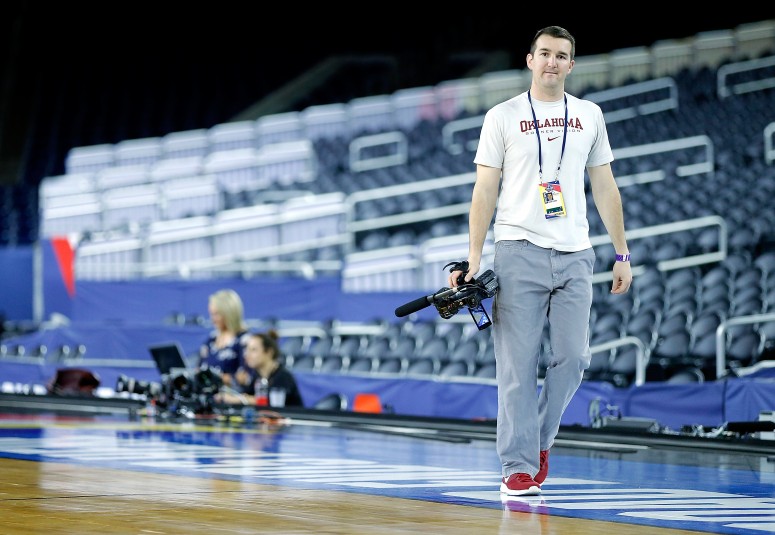The New Age of Content: Live Video and Social Media Are on a Collision Course, and It’s Great News
Story Highlights
The digital revolution has been dramatically reshaping our world since the middle of last century. Like waves smacking against a shoreline, a burst of innovation seems to shake up our lives every handful of years. Massive changes in the way Americans consume media and communicate with each other have had profound effects on the world around us.
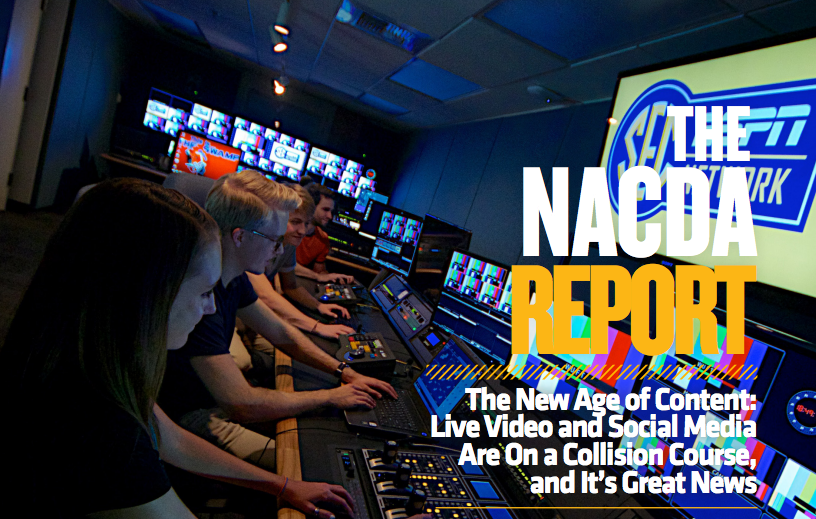 Intercollegiate athletics, in and of itself, is always a rapidly changing landscape, but few areas of the industry have seen greater upheaval than video production, and it’s a direct result of the digitization of media and technology. Whether live or on-demand, marketing or in-venue, athletics departments large and small have invested significant resources into video production.
Intercollegiate athletics, in and of itself, is always a rapidly changing landscape, but few areas of the industry have seen greater upheaval than video production, and it’s a direct result of the digitization of media and technology. Whether live or on-demand, marketing or in-venue, athletics departments large and small have invested significant resources into video production.
The Sports Video Group and its SVG College Initiative recently surveyed 88 Division I institutions of various shapes and sizes, and the numbers are not surprising: 95 percent say they are in the business of both live game production and on-demand (features, interviews, highlight packages) content creation, and just over 50 percent of schools say they oversee more than 30 video productions per month.
It’s all being done in-house. 12th Man Productions. HuskerVision. SoonerVision. Razorback Productions. That’s just a tiny sampling of the capabilities that have grown within athletics departments over the past decade to support this growing space. To outline how we have gotten here, first, let’s trace how technology has made this possible and how some of the biggest sports and media brands are using tech innovations to change how they create more video at a fraction of the cost. From there, we will move on to how setting up these technological foundations will open content creators up to a wide world of creativity.
IP Is the Way To Be
Looking at sports-television production, there is no greater trend impacting the industry right now than the exponential growth in “at-home” production models. Another result of the digital revolution has been the birth of transmission via the Internet. Today, major broadcasters have improved their craft and become most comfortable with using IP-based technology to enable at-home workflows, allowing a control room at a broadcast center instead of a massive remote-production truck at the event site. As a result, sports-content producers are able to cut costs by reducing onsite resources while boosting production capabilities.
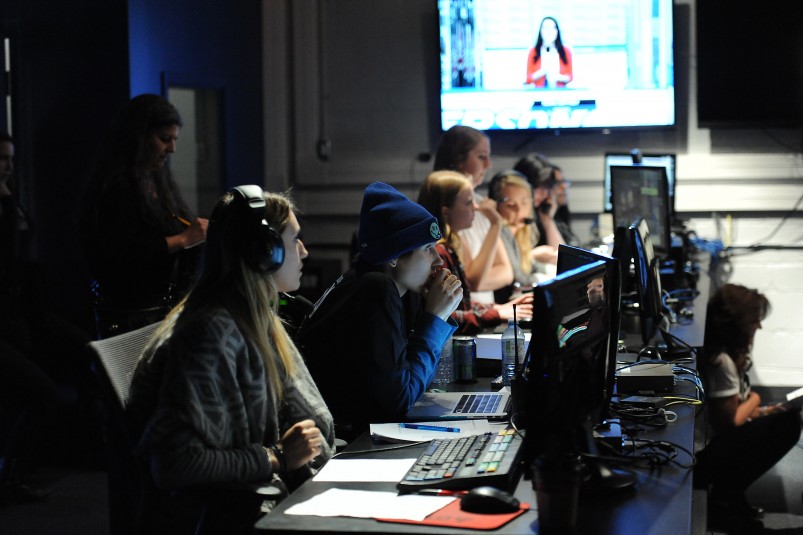 “We are making more with less,” says Scott Adametz, Pac-12 Networks, Director, System Architecture & Technology. “The whole [reason] we went with this approach was budget. We had to produce this content because leaving this content on the floor was not an option. But we didn’t want to do it and lower quality. These are not A-level events; they are events that wouldn’t otherwise be produced or would be streamed only.”
“We are making more with less,” says Scott Adametz, Pac-12 Networks, Director, System Architecture & Technology. “The whole [reason] we went with this approach was budget. We had to produce this content because leaving this content on the floor was not an option. But we didn’t want to do it and lower quality. These are not A-level events; they are events that wouldn’t otherwise be produced or would be streamed only.”
Fittingly enough, this is another area where intercollegiate athletics has been at the forefront of innovation. At-home workflows are seen every day in centralized control rooms: a singular space is connected to multiple athletic venues via fiber to produce live-streamed and/or in-venue videoboard shows. No need to roll in an expensive truck. No need for portable gear. And, certainly, no need to build a control room at each major venue.
Two years ago, 35 percent of respondents in our Division I survey reported hosting a centralized control room on campus and using it as the primary source of live athletic-event production and content generation. This year, that number has risen to 49 percent.
After some serious politicking, athletics departments are building relationships with university IT departments and accessing valuable dark fiber already built into university infrastructures and leveraging it for video production.
That is not to say that a centralized control room is the uniform answer. Every campus is unique, and, for many schools, a centralized control room may not make sense if athletic facilities are miles away from other facilities or the main academic campus. However, the model has emerged as the popular choice, and a fiber infrastructure offers tremendous flexibility and opportunities for all intercollegiate athletics programs, including Olympic sports.
Asset Management Is More Than a Safety Net
Another trend illuminated by our industry survey is the growing concern over video storage and management. The move to file-based workflows has dramatically altered how content is perceived on the backend. Now it’s not about preserving tapes; it’s about using hard drives and the cloud to protect digital assets loaded with metadata, making them both accessible and monetizable.
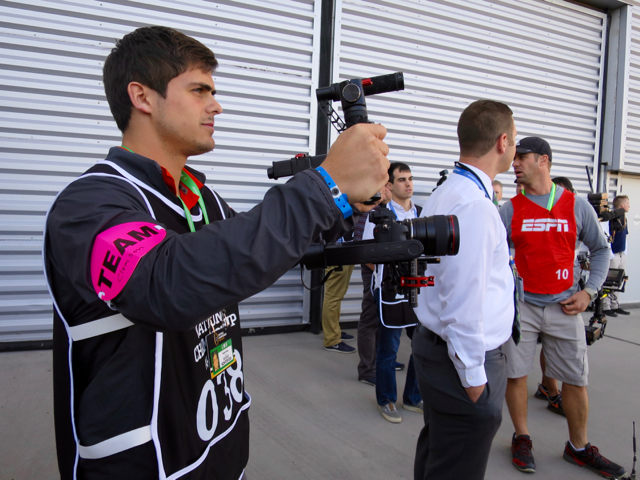 College athletics departments understand that this is a growing issue. When we surveyed Division I institutions in 2014, a whopping 78 percent of respondents stated that they were looking to invest in storage and archival systems and services, making it, by far, the most popular among the options offered (graphics, replay, production switcher, cameras). In our 2016 study, that number still holds strong, at 67 percent.
College athletics departments understand that this is a growing issue. When we surveyed Division I institutions in 2014, a whopping 78 percent of respondents stated that they were looking to invest in storage and archival systems and services, making it, by far, the most popular among the options offered (graphics, replay, production switcher, cameras). In our 2016 study, that number still holds strong, at 67 percent.
Asset management is hardly the flashiest project to undertake, but it has proved a critical infrastructure cornerstone for professional sports leagues and networks. The NFL, NBA, NHL, MLB, and PGA have made massive investments in building robust digital archives to properly preserve their history and, perhaps most important, make all assets accessible and usable by content creators.
Digital-asset management requires a lot of upfront work and investment, but it can set a program up for success for decades to come. Granted, a more user-friendly, flexible, and cost-effective solution needs to be developed on the manufacturer end before these investments begin to happen en masse.
Engagement Is Personal
The barrier to entry of live video production has dropped dramatically, thanks to the democratization of production. Gear is cheaper and easier to use, and the Internet has made distribution simpler than ever.
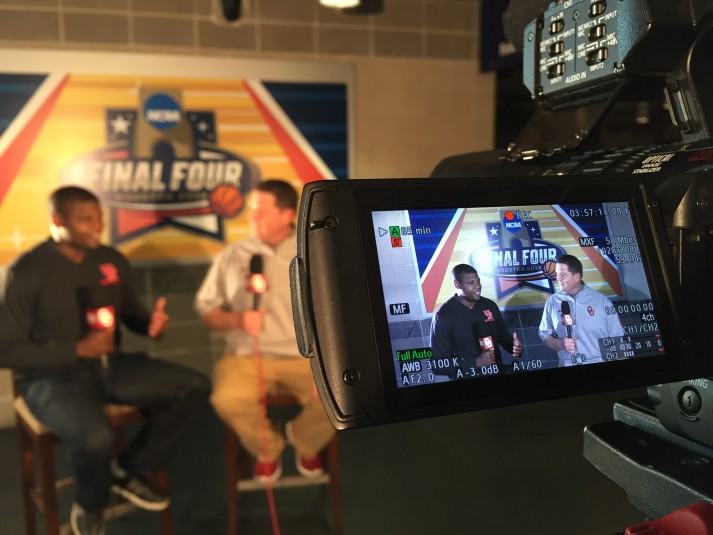 As noted, intercollegiate athletics departments have certainly accepted the challenge of becoming content creators and storytellers. Now that we have overcome the technological challenges of content and distribution, we get to move on to the creative challenge: what makes good, engaging content?
As noted, intercollegiate athletics departments have certainly accepted the challenge of becoming content creators and storytellers. Now that we have overcome the technological challenges of content and distribution, we get to move on to the creative challenge: what makes good, engaging content?
Video still reigns as the best way for athletics departments and conferences to engage with fans and alumni, all year long as well as on game day. Since the days of America’s first televised sports event (which, by the way, was a college baseball game between Columbia and Princeton on NBC in May 1939), this has been true. However, for the first time since then, the days of “broadcasting” may be numbered.
“Five years ago, if you looked where all of the leagues were, it was mass communication, and it actually wasn’t very good,” says Michael Rubin, founder/executive chairman of online retailer Fanatics and co-owner of the Philadelphia 76ers. “When I look at where we are today, it’s become incredibly customized and personalized and targeted, and what that’s allowed us to do is communicate that much more where the fan loves it.”
We live in a niche world. Interests are fragmented, and fans are asking for a deeper, more personal connection with the programs and athletes they support. While much is made of creating powerful websites and mobile applications fully loaded with your own branding and messaging, one fact is glaringly clear: fans don’t care where they engage with your content. They think less about your platform and more about the media they choose to make a part of their every-day lives.
Social Media Is Distribution
For these reasons, it’s time to stop thinking of social media as “social media” and instead understand that each platform (Facebook, Twitter, Instagram, Snapchat) is a completely independent method of distribution, equal in importance to that of your own website or mobile app.
“The vast majority of teams still use social media as an extension of their PR department,” says Jonathan Kraft, president, The Kraft Group, which owns the New England Patriots, New England Revolution, and Gillette Stadium. “The team will put out a press release and put it out on Twitter, and it’s the exact same post. We look at every single post that we make on every type of social-media platform, and we analyze each thing that we do. Each of the four major social-media options [Facebook, Twitter, Instagram, Snapchat] has a different connotation. Twitter is hard news. Facebook is more lifestyle. Instagram is great for visual moments, and Snapchat is the real-time event stuff. We spend a lot of time analyzing this.”
As a result, the Patriots are regularly at the top of many lists of NFL and sports teams in the U.S. in terms of engagement, which tracks the rate at which social-media posts are shared, commented on, and interacted with.
“That’s much more important to us than any other metric, because, if you are number one in engagement, that means that you’re building that connection. Without the analytic capabilities we have built in-house, we wouldn’t be able to do it, and it’s a great investment in the long-term equity of our business.”
Why Facebook Still Rises to the Top
Facebook has become the top video-distribution engine in the world outside of television. And, for a content creator, the barrier to entry on that platform is staggeringly lower. Think of everything you need to start a television network: cameras, control room, satellite time, programming agreements with a multitude of cable distributors. To broadcast live to your Facebook followers, you need…the smartphone in your pocket.
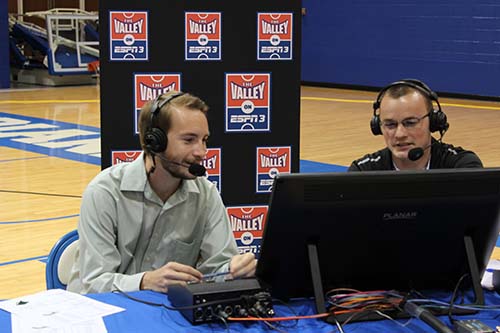 According to Facebook’s Q3 2015 earnings report in November, its daily video views have hit 8 billion. That’s double the number credited to YouTube each day. Even if the platforms were neck-and-neck, it would still be very telling.
According to Facebook’s Q3 2015 earnings report in November, its daily video views have hit 8 billion. That’s double the number credited to YouTube each day. Even if the platforms were neck-and-neck, it would still be very telling.
Despite all talk of the decline in younger Facebook users and the rise of platforms built for the visual world (Instagram, Vine, Snapchat), Facebook is still king and will apparently keep its throne for some time. This is fantastic news for collegiate athletics departments because, according to survey results recently released by Repucom International on behalf of WME-IMG, 73 percent of college-basketball fans and 78 percent of college-football fans say they use Facebook to engage with their favorite sport.
Future Opportunities as Social and Live Video Unite
It’s the perfect marriage. Facebook is the king of video, and, in the past year, live video streaming on social media has become commonplace. Now that many sports leagues appear to have overcome their early fears, first half 2016 has seen some of the largest brands in the country experiment with the possibilities of Facebook Live and Periscope.
These platforms are going to shift very rapidly from hosting content supplementing or enhancing live television and events to serving as a primary host for both.
Why pay hefty fees to a local RSN to air a postgame show and hope fans tune in, when a video team can produce a 10- to 20-minute live postgame show from your own studios (or the sideline) and directly hit the Facebook News Feed and notification feeds of engaged fans who have chosen to follow you?
It’s a phenomenal time for creativity, and intelligent and innovative content creators are the valuable lifeblood of any media organization. The pure concept of storytelling is inherent in all these forms of distribution. Which is why, despite being a sports-technology industry organization, we always agree wholeheartedly that the warm body is a far wiser investment than the cold box.
This piece originally was originally published in coordination with the National Association of Collegiate Directors of Athletics at www.nacda.com.
